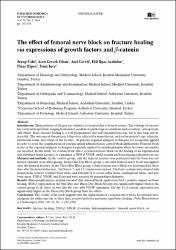| dc.contributor.author | Uslu, Serap | |
| dc.contributor.author | İrban Gerçek, Arzu | |
| dc.contributor.author | Gereli, Arel | |
| dc.contributor.author | Aydınlar Ilgaz, Elif | |
| dc.contributor.author | Elpen, Pınar | |
| dc.contributor.author | İnce, Ümit | |
| dc.date.accessioned | 10.07.201910:49:13 | |
| dc.date.accessioned | 2019-07-10T19:56:02Z | |
| dc.date.available | 10.07.201910:49:13 | |
| dc.date.available | 2019-07-10T19:56:02Z | |
| dc.date.issued | 2016 | en_US |
| dc.identifier.citation | Uslu, S., İrban Gerçek, A., Gereli, A., Aydınlar Ilgaz, E.,Elpen, P. ve İnce, Ü. (2016). The effect of femoral nerve block on fracture healing via expressions of growth factors and beta-catenin. Folia Histochemica Et Cytobiologica, 54(3), 151-158. https://dx.doi.org/10.5603/FHC.a2016.0017 | en_US |
| dc.identifier.issn | 0239-8508 | |
| dc.identifier.issn | 1897-5631 | |
| dc.identifier.uri | https://dx.doi.org/10.5603/FHC.a2016.0017 | |
| dc.identifier.uri | https://hdl.handle.net/20.500.12511/2534 | |
| dc.description | WOS: 000392717800006 | en_US |
| dc.description | PubMed ID: 27654016 | en_US |
| dc.description.abstract | Introduction. Many patients of all ages are admitted to hospital due to bone fractures. The etiology of fracture has a very wide spectrum, ranging from motor accidents to pathological conditions such as tumors, osteoporosis, and others. Bone fracture healing is a well-programmed and well-organized process, but is also long and intractable. The outcome of this process is therefore affected by many factors, such as the patient's age, ethnicity, nutritional status, and extent of the fracture. At present, regional analgesic techniques are frequently applied in order to avoid the complications of systemic opioid administration, central block applications. Femoral block is one of the regional analgesic techniques frequently applied by anesthesiologists when the lower extremities are involved. In this study, we evaluated the effect of femoral nerve block on the healing of an experimental non-stabilized femur fracture via expression of TGF-beta, VEGF, and beta-catenin and bone histomorphometry in rats. Material and methods. In the control group, only the femoral fracture was performed and the bone was not fixated, similarly as in other groups. In the One-Day Block group, a one-time femoral nerve block was applied after the femoral fracture. In the Three-Day Block group, a daily femoral nerve block was performed for three days after the femoral fracture. On Days 4, 7, and 13, femurs were excised. The bone sections were stained with hematoxylin-eosin to evaluate bone tissue and Safranin O to assess callus tissue, cartilaginous tissue, and new bone areas. TGF-beta, VEGF, and beta-catenin were assessed by immunohistochemistry. Results. Histomorphometric analysis revealed that femoral block application had a positive impact on bone healing. TGF-beta expression in the One-Day and Three-Day Block Groups was significantly higher than in the control group at all times, as was also the case with VEGF expression. On day 13, beta-catenin expression was significantly higher in the Three-Day Block group than the others. Conclusions. The results of the study suggests that the applications of a femoral nerve block for perioperative analgesia, for either one day or three days, resulted in better and more rapid bone healing. | en_US |
| dc.description.sponsorship | Turkish Regional Anesthesia Association at 13th National Regional Association Congress | en_US |
| dc.description.sponsorship | This study was awarded with Best Free Paper by Turkish Regional Anesthesia Association at 13th National Regional Association Congress, 2013. | en_US |
| dc.language.iso | eng | en_US |
| dc.publisher | Via Medica | en_US |
| dc.rights | info:eu-repo/semantics/openAccess | en_US |
| dc.subject | Fracture Healing | en_US |
| dc.subject | TGF-Beta | en_US |
| dc.subject | VEGF | en_US |
| dc.subject | Beta-Catenin | en_US |
| dc.subject | Histomorphometry | en_US |
| dc.subject | Femoral Nerve Block | en_US |
| dc.subject | Rat | en_US |
| dc.title | The effect of femoral nerve block on fracture healing via expressions of growth factors and beta-catenin | en_US |
| dc.type | article | en_US |
| dc.relation.ispartof | Folia Histochemica Et Cytobiologica | en_US |
| dc.department | İstanbul Medipol Üniversitesi, Tıp Fakültesi, Cerrahi Tıp Bilimleri Bölümü, Anesteziyoloji ve Reanimasyon Ana Bilim Dalı | en_US |
| dc.identifier.volume | 54 | en_US |
| dc.identifier.issue | 3 | en_US |
| dc.identifier.startpage | 151 | en_US |
| dc.identifier.endpage | 158 | en_US |
| dc.relation.publicationcategory | Makale - Uluslararası Hakemli Dergi - Kurum Öğretim Elemanı | en_US |
| dc.identifier.doi | 10.5603/FHC.a2016.0017 | en_US |
| dc.identifier.wosquality | Q4 | en_US |
| dc.identifier.scopusquality | Q2 | en_US |


















